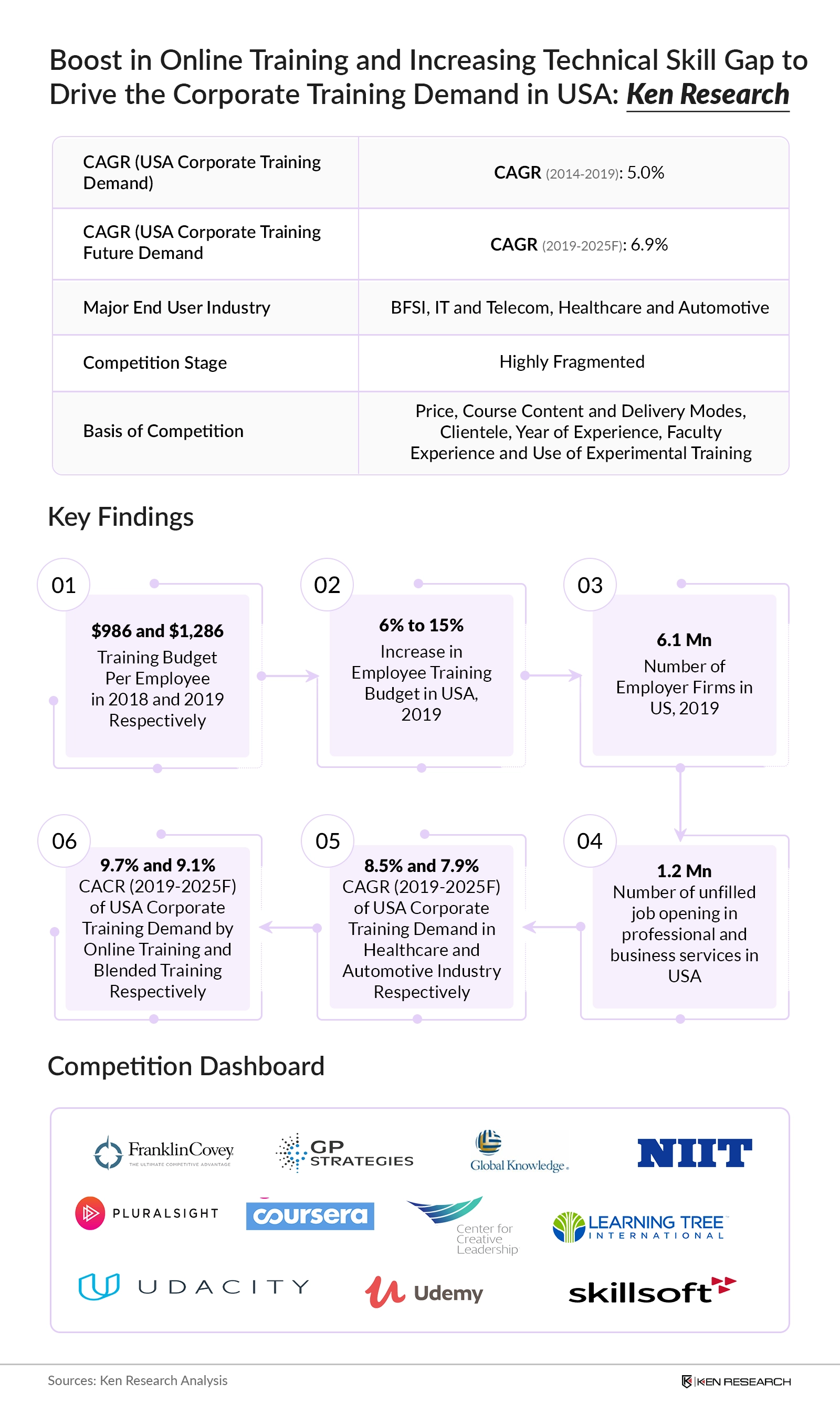
US Corporate Training Market Outlook to 2025
Driven by Growing Skill Gap with Disrupting Technology Stack and Penetration of Self Paced, Live Instructor Led Online Training Modes
Region:North America
Author(s):Saloni Bhalotiya, Prahaladh Hariharan
Product Code:KR976
April 2020
73
About the Report
The report titled “US Corporate Training Market Outlook to 2025 – Driven by Growing Skill Gap with Disrupting Technology Stack and Penetration of Self Paced, Live Instructor Led Online Training Modes" provides a comprehensive analysis of the in the USA. The report also initiative by explaining the need and opportunity of the corporate training industry. Further, it proceeds with an explanation of current demand and demand by different segments. It also includes the trends, developments, challenges, technological stack, revenue streams, marketing strategies, and government regulations driving the industry. It gives a detailed explanation of competitive scenarios including cross-comparison between major players, Porter’s Five Force Analysis, and detailed company profiles of major players. It concludes with future scope and analyst recommendations.

Market Overview and Demand Scenario
Low employee retention, growing skill gap, low college enrollment, and the increasing cost of ineffective training were some of the important pain points of companies that lead to the introduction of the . The USA Corporate training industry is currently positioned to be at a late growth stage. The demand is increasing with a CAGR close to 5% during the period 2014-2019. There is an increasing trend in the use of Microlearning modules, experimental training, and the development of customized and specific training solutions.
Demand by End-User Industry (BFSI, IT and Telecom, Healthcare, Automotive, Manufacturing, and others): The growing importance of cyber-security with the increasing use of digital banking technologies including digital banking, Blockchain, and others has to lead to the increasing demand for training in the BFSI industry. Data Science & Analytics and Big Data Programs have revolutionized the IT and telecom Industry leading to quick outdating of skills among its employees. In the healthcare industry, the training demand is driven during the need for disease prevention training such as training to deal with highly infectious diseases such as Coronavirus, Ebola, SARS, etc. Introduction of electric & automated vehicles and development in 3D Printing technology is driving the demand in the automotive and manufacturing industries respectively.
Demand By Delivery Mode (Classroom Training, Blended Training, Virtual Training, Online Training (no instructor) and others): The demand is still dominated by classroom training methodology due to inertia caused by traditional mind-set. Blended training is increasing gaining pace as it has found to provide marginally higher ROIs for global setups as compared to the only classroom or only online modules. Channing workstyle and increasing need for flexibility will eventually lead to a substitution of offline to online training.
By Type of Training Services (Technical, Leadership, Managerial, Sales, Customer Support and Others): Technical training dominates the training demand due to the increasing use of technology and the growing digitalization of business operations. Dynamic business strategies, increasing organizational decentralization and growing millennial workforce drives the demand for leadership and managerial training.
By Deployment (On-Site and Off-Site): Increasing demand for skill-based training for which resources are available within office premises to boost the demand for on-site training. Large and mid-size enterprises look for managed training services (multi-year contracts) which involves multiple training programs to be conducted within their offices.
Competitive Landscape
The industry is highly fragmented with the presence of various large public and private training companies as well as thousands of small training start-ups. Price, Course Content, Year of Experience, Faculty Qualification, Use of Experimental Training, and Clientele are few of the important competition parameters. The major players include GP Strategies, Franklin Covey, Global Knowledge, Learning Tree International, Pluralsight, NIIT, Centre for Creative Leadership, Skillsoft, Udemy, Udacity, Coursera and Simplilearn
Future Outlook and Projection
The demand is expected to grow with a CAGR of 6.9% during the period 2019-2025. The demand is expected to be driven by a growing interconnected society due to the advent of AI, Blockchain, IoT, 3D Printing, and others. E-learning is gradually taking over because of low priced modules and flexibility in learning. The shift to remote workstyle and growing government support will further boost the demand in the industry.
Key Topics Covered in the Report:-
- Current Pain Points of Companies Leading to Development of Corporate Training Industry
- Target Addressable Audience
- Supply Ecosystem and Competition Parameters
- Demand Scenario
- Technological Stack
- Revenue Streams
- Marketing Strategies
- Challenges Faced by Corporate Training Companies
- Porter Five Force Analysis
- Emerging Business Strategies
- Best Practises in Business
Products
Key Target Audience
Corporate Training Companies
Education Platforms
Corporate Training Aggregators
Corporate Organizations
Management Consultants
Corporate Trainers
MHRD
Education Associations
Time Period Captured in the Report:-
Historical Period: 2014–2019
Forecast Period: 2020-2025
Companies
Key Segments Covered:
By End User Industry
BFSI
IT and Telecom
Healthcare
Automotive
Manufacturing
By Training Services
Technical
Leadership
Managerial
Sales
Customer Support
By Delivery Mode
Classroom Training
Blended Training
Virtual Training
Online Training (No Instructor)
By Organizational Size
Large Companies (+1000 Employees)
Medium Companies (500-1000 Employees)
Small Companies (0-500 Employees)
By Designation
Managerial
Non-Managerial
Integrated
By Deployment
On-Site
Off-Site
By Training Type
Customized
Open
Companies Covered:
GP Strategies
Franklin Covey
NIIT
Learning Tree International
Global Knowledge
Pluralsight
Centre for Creative Leadership
Skillsoft
Udemy
Udacity
Coursera
Simplilearn
Table of Contents
1. Executive Summary
USA Corporate Training Demand Flow Chart, 2019
USA Corporate Training Demand Flow Chart, 2025F
2. Need and Opportunity
Present Day Pain Points of Corporate Employees and Companies
Target Addressable Market (Number of Corporate Enterprises and Corporate Employees)
Employee Training Trend Analysis Survey
3. Supply Scenario
Supply Ecosystem (Top Blended Service Providers, Online Corporate Training Aggregator Platforms and Online Corporate Training Platforms)
Competition Parameters (Price, Clientele, Years of Experience, Course Content and Delivery Modes, Experienced Faculty and Use of Creative Methods)
4. Demand Scenario
USA Corporate Training Demand, 2014-2019 and Growth Drivers
USA Corporate Training Demand by Organisational Size (Large, Medium and Small) and By Designation (Managerial, Non-Managerial and Integrated), 2014-2019
USA Corporate Training Demand by Delivery Mode and Cross Comparison (Classroom, Blended, Online Training (no instructor), Virtual Training and Others), 2014-2019
5. End User Industry Analysis
Demand by BFSI Industry Training Expenditure (Banking Operations, Sales Support and Process, Customer Support and Relationship Management and Managerial Development), 2019
Demand by IT and Telecom Industry Training Expenditure (IT Courses, Sales and Backend Support and Customer Support)
Demand by Healthcare Industry Training Expenditure (Technical, Sales and Customer Support)
Demand by Automotive Industry Training Expenditure (Technical, Sales, Customer Support and Managerial Development)
6. Industry Analysis
Corporate Training Technological Stack
Corporate Training Revenue Streams
Challenges Faced by Corporate Training Companies (Inertia of Traditional Methods, Retaining Key Personnel, Contract Termination Uncertainty and Cost Overruns, Revenue Seasonality)
Online and Offline Marketing Strategy (Including Case Study of GP Strategies)
7. Competition Scenario
Porter’s Five Force Analysis
Business Capabilities of Major Corporate Training Companies (Content Customization, Major Clients, Major Courses and Online/Offline)
Operational and Financial Landscape (Employee Size, Number of Trainers, Training Per Month, Students Per Session and Revenue)
Cross Comparison between Online Corporate Training Players (Revenue, Number of Users, Number of Courses, Years of Experience, Focus Area and Global Enterprise Clients)
Company Profile of Major Corporate Training Companies including GP Strategies, Franklin Covey, Global Knowledge, NIIT, Centre for Creative Leadership, Learning Tree International, Pluralsight, Skillsoft, Udemy, Coursera, Udacity and Simplilearn (Company Overview, Course Structure, Business Strategies, USP, Major Clients, Recent Developments, Key Financials, M&A and Funding Rounds)
8. Future Demand Analysis
Future Corporate Training Demand, 2025F and Effect of 4th Industrial Revolution
Government Regulation Driving the Industry
Future Demand By Organizational Size (Large, Medium and Small) and By Designation (Managerial, Non-Managerial and Integrated), 2025F
Future Demand By Training Type (Customized and Open) and By Deployment (On-Site and Off-Site), 2025F
Future Demand By End User Industry (BFSI, IT and Telecom, Healthcare, Automotive, Manufacturing and Others), 2025F
Future Demand By Training Service (Technical, Leadership, Managerial, Customer Support, Sales and Others), 2025F
Future Demand By Mode of Training Delivery (Classroom, Blended, Online Training (no instructor), Virtual Training and Others), 2025F
9. Analyst Recommendations
Emerging Business Strategies
Recommended Best Practises in Business
10. Appendix
Research Methodology
Corporate Training Expenditure Survey Respondent Profile
Corporate Training Expenditure Survey Results
Disclaimer
Contact Us
Why Buy From Us?

What makes us stand out is that our consultants follows Robust, Refine and Result (RRR) methodology. i.e. Robust for clear definitions, approaches and sanity checking, Refine for differentiating respondents facts and opinions and Result for presenting data with story

We have set a benchmark in the industry by offering our clients with syndicated and customized market research reports featuring coverage of entire market as well as meticulous research and analyst insights.

While we don't replace traditional research, we flip the method upside down. Our dual approach of Top Bottom & Bottom Top ensures quality deliverable by not just verifying company fundamentals but also looking at the sector and macroeconomic factors.

With one step in the future, our research team constantly tries to show you the bigger picture. We help with some of the tough questions you may encounter along the way: How is the industry positioned? Best marketing channel? KPI's of competitors? By aligning every element, we help maximize success.

Our report gives you instant access to the answers and sources that other companies might choose to hide. We elaborate each steps of research methodology we have used and showcase you the sample size to earn your trust.

If you need any support, we are here! We pride ourselves on universe strength, data quality, and quick, friendly, and professional service.















